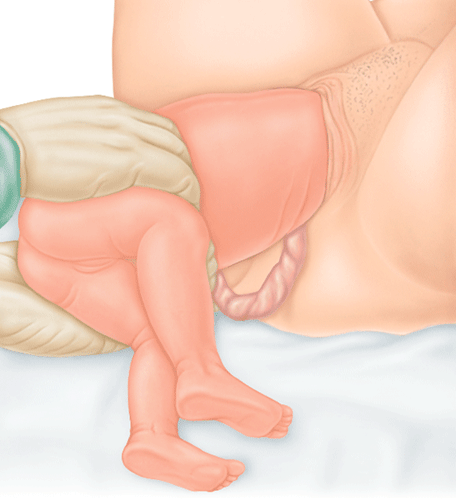A natural breech birth
If you are having a natural
vaginal delivery with a breech birth, this will be carefully handled by
an obstetrician. A vaginal breech birth can be slower than a head-first,
cephalic, delivery as the bottom doesn't push down as much. The
obstetrician will guide the baby out. Usually, the buttocks are
delivered first and then the legs will be carefully guided out. The baby
may then be rotated to deliver the shoulders as smoothly as possible.
Lastly, the weight of the baby helps to draw the head down for delivery.
A vaginal breech birth:
This happens in stages as
the baby is carefully guided out by an obstetrician. Once the buttocks
and shoulders have been delivered, the weight of the baby's body then
helps to draw down the head for delivery.
Stage 1

Stage 2

Stage 3

Positions for the second stage of labor
Although by this point in
your labor you may be extremely tired and the contractions are lasting
longer, it is best to resist any urge to lie down since this will not
help the progress of the baby through the birth canal. Your partner can
help support you while you hold certain positions and help you remain
upright if possible so that gravity can assist your baby. Many women
find squatting or kneeling on all fours the most comfortable, or if you
really need to lie down, get your partner to support one leg so that the
pelvis can remain as open as possible.
Sitting upright with supporting pillows helps you to relax between contractions.

Your partner and midwife can support you in upright positions.

Kneeling enables gravity to push the baby down the birth canal.

What happens to the placenta? Checking the afterbirth
The placenta
has sustained your baby during her nine months in the womb, and what
happens to it after its delivery is a common question.
The placenta
will be checked to ensure it is complete and has been delivered
successfully. If it looks healthy, it will be disposed of at the
hospital.
It may be taken away for analysis in a laboratory if there is anything unusual in its appearance.
Some
cultures perform ceremonies with the placenta; and in some parts of the
world there is even a tradition of eating the placenta.
NOTE
Your newborn baby may look a bit scary—slippery and covered in blood—but embracing him in your arms is a great welcome